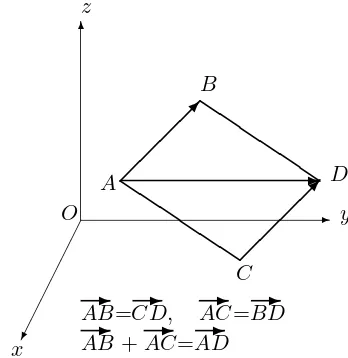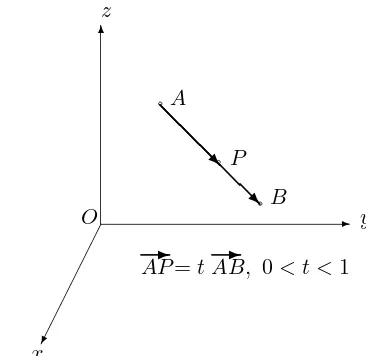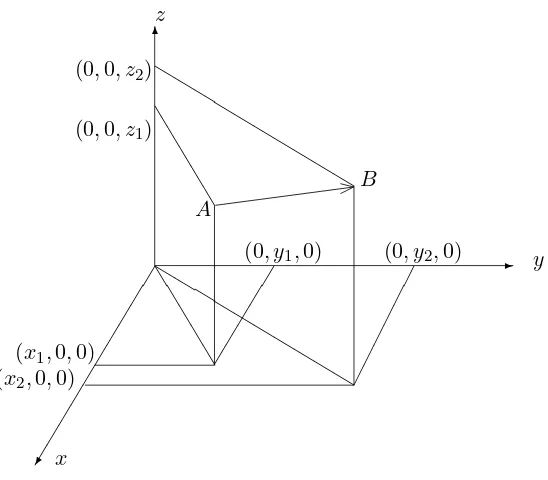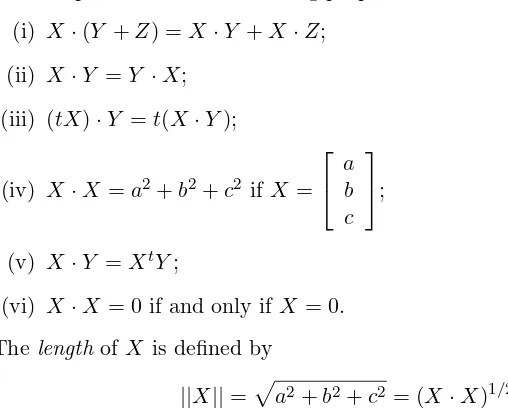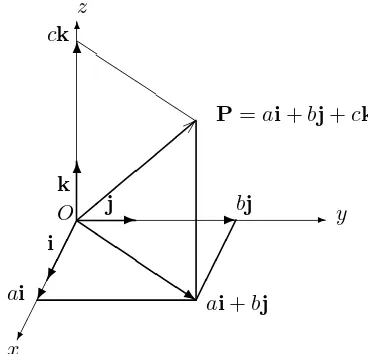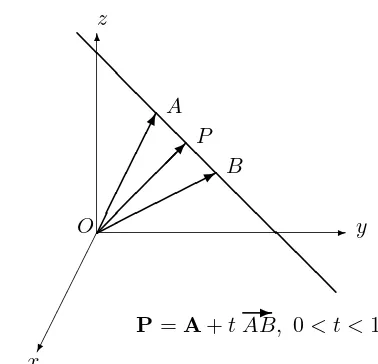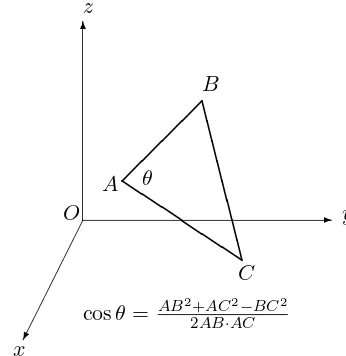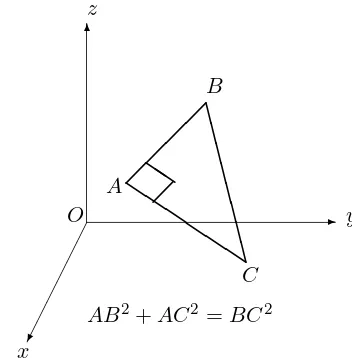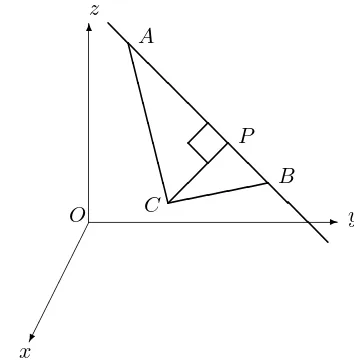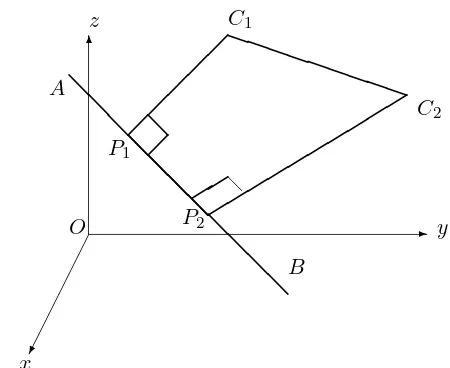Chapter 8
THREE–DIMENSIONAL
GEOMETRY
8.1
Introduction
In this chapter we present a vector–algebra approach to three–dimensional geometry. The aim is to present standard properties of lines and planes, with minimum use of complicated three–dimensional diagrams such as those involving similar triangles. We summarize the chapter:
Points are defined as ordered triples of real numbers and the distance between points P1 = (x1, y1, z1) and P2 = (x2, y2, z2) is defined by the formula
P1P2 = p
(x2−x1)2+ (y2−y1)2+ (z2−z1)2. Directed line segments
✲
AB are introduced as three–dimensional column vectors: IfA= (x1, y1, z1) andB = (x2, y2, z2), then
✲
AB=
x2−x1
y2−y1
z2−z1
.
If P is a point, we letP=
✲
OP and call Ptheposition vector ofP. With suitable definitions of lines,parallel lines, there are important ge-ometrical interpretations of equality, addition and scalar multiplication of vectors.
(i) Equality of vectors: SupposeA, B, C, D are distinct points such that no three are collinear. Then AB✲=CD✲ if and only if AB✲ k CD✲ and
✲
✁ ✁ ✁ ✁ ✁ ✁☛
✲ ✻
y z
x O
✒
✲
A ✒
C
◗◗ ◗◗
◗◗
D
◗◗ ◗◗
◗◗
B
✲
AB✲=CD,✲ AC✲=BD✲ AB+AC✲=AD✲
Figure 8.1: Equality and addition of vectors.
(ii) Addition of vectors obeys theparallelogram law: LetA, B, C be non– collinear. Then
✲
AB+AC✲=AD,✲
where D is the point such that AB✲ k CD✲ and AC✲ k BD✲. (See Fig-ure 8.1.)
(iii) Scalar multiplication of vectors: Let AP✲=tAB✲, where A and B are distinct points. ThenP is on the line AB,
AP AB =|t|
and
(a) P =A ift= 0, P =B ift= 1; (b) P is between Aand B if 0< t <1; (c) B is between A and P if 1< t; (d) Ais between P and B ift <0.
8.1. INTRODUCTION 151
✁ ✁ ✁ ✁ ✁ ✁☛
✲ ✻
y z
x O
❅ ❅
❅ ❅
❅ ❘ ❅
❅ ❅ ❘ P A
B
✲
AP=tAB,✲ 0< t <1
Figure 8.2: Scalar multiplication of vectors.
Thedot productX·Y of vectorsX =
a1
b1
c1
andY =
a2
b2
c2
, is defined by
X·Y =a1a2+b1b2+c1c2. The length||X|| of a vectorX is defined by
||X||= (X·X)1/2 and theCauchy–Schwarz inequalityholds:
|X·Y| ≤ ||X|| · ||Y||.
Thetriangle inequality for vector length now follows as a simple deduction:
||X+Y|| ≤ ||X||+||Y||.
Using the equation
AB=||AB✲ ||,
we deduce the corresponding familiartriangle inequality for distance:
The angleθ between two non–zero vectorsX and Y is then defined by
cosθ= X·Y
||X|| · ||Y||, 0≤θ≤π.
This definition makes sense. For by the Cauchy–Schwarz inequality,
−1≤ X·Y
||X|| · ||Y|| ≤1.
VectorsX andY are said to beperpendicularororthogonalifX·Y = 0. Vectors of unit length are calledunit vectors. The vectors
i=
1 0 0
, j=
0 1 0
, k=
0 0 1
are unit vectors and every vector is a linear combination ofi,jand k:
a b c
=ai+bj+ck.
Non–zero vectors X and Y are parallel or proportional if the angle be-tweenX and Y equals 0 orπ; equivalently if X=tY for some real number
t. Vectors X and Y are then said to have the same or opposite direction, according as t >0 or t <0.
We are then led to study straight lines. If A and B are distinct points, it is easy to show that AP+P B=AB holds if and only if
✲
AP=t
✲
AB, where 0≤t≤1.
A lineis defined as a set consisting of all points P satisfying
P=P0+tX, t∈ R or equivalently
✲
P0P=tX,
for some fixed pointP0 and fixed non–zero vectorX called adirection vector for the line.
Equivalently, in terms of coordinates,
x=x0+ta, y=y0+tb, z=z0+tc,
8.1. INTRODUCTION 153
There is then one and only one line passing passing through two distinct pointsA andB. It consists of the points P satisfying
✲
AP=t
✲
AB,
wheretis a real number.
Thecross–productX×Y provides us with a vector which is perpendicular to bothX andY. It is defined in terms of the components ofX andY:
LetX =a1i+b1j+c1k andY =a2i+b2j+c2k. Then
X×Y =ai+bj+ck,
where
a=
b1 c1
b2 c2
, b=−
a1 c1
a2 c2
, c=
a1 b1
a2 b2
.
The cross–product enables us to derive elegant formulae for the distance from a point to a line, the area of a triangle and the distance between two skew lines.
Finally we turn to the geometrical concept of a plane in three–dimensional space.
A planeis a set of pointsP satisfying an equation of the form
P=P0+sX+tY, s, t∈ R, (8.1)
whereX and Y are non–zero, non–parallel vectors. In terms of coordinates, equation 8.1 takes the form
x = x0+sa1+ta2
y = y0+sb1+tb2
z = z0+sc1+tc2,
whereP0= (x0, y0, z0).
There is then one and only one plane passing passing through three non–collinear pointsA, B, C. It consists of the points P satisfying
✲
AP=sAB✲ +tAC,✲
wheresand tare real numbers.
The cross–product enables us to derive a concise equation for the plane through three non–collinear pointsA, B, C, namely
✲
When expanded, this equation has the form
ax+by+cz=d,
where ai+bj+ck is a non–zero vector which is perpendicular to
✲
P1P2 for all pointsP1, P2 lying in the plane. Any vector with this property is said to be a normal to the plane.
It is then easy to prove that two planes with non–parallel normal vectors must intersect in a line.
We conclude the chapter by deriving a formula for the distance from a point to a plane.
8.2
Three–dimensional space
DEFINITION 8.2.1 Three–dimensional space is the set E3 of ordered triples (x, y, z), wherex, y, zare real numbers. The triple (x, y, z) is called a pointP inE3
and we writeP = (x, y, z). The numbers x, y, zare called, respectively, thex, y, z coordinates of P.
The coordinate axesare the sets of points:
{(x,0,0)} (x–axis),{(0, y, 0)} (y–axis),{(0,0, z)} (z–axis). The only point common to all three axes is theorigin O= (0,0,0). The coordinate planesare the sets of points:
{(x, y,0)} (xy–plane),{(0, y, z)} (yz–plane),{(x,0, z)} (xz–plane). The positive octant consists of the points (x, y, z), where x > 0, y >
0, z >0.
We think of the points (x, y, z) with z >0 as lying above thexy–plane, and those withz <0 as lying beneath the xy–plane. A point P = (x, y, z) will be represented as in Figure 8.3. The point illustrated lies in the positive octant.
DEFINITION 8.2.2 Thedistance P1P2 between pointsP1= (x1, y1, z1) and P2 = (x2, y2, z2) is defined by the formula
P1P2 = p
(x2−x1)2+ (y2−y1)2+ (z2−z1)2. For example, ifP = (x, y, z),
8.2. THREE–DIMENSIONAL SPACE 155
Figure 8.3: Representation of three-dimensional space.
✲ y
Figure 8.4: The vector
✲
DEFINITION 8.2.3 If A = (x1, y1, z1) and B = (x2, y2, z2) we define the symbol
✲
AB to be the column vector
✲
AB=
x2−x1
y2−y1
z2−z1
.
We let P=OP✲ and call Ptheposition vector ofP.
The components of
✲
AB are the coordinates of B when the axes are translated toA as origin of coordinates.
We think of AB✲ as being represented by the directed line segment from
A toB and think of it as an arrow whose tail is at Aand whose head is at
B. (See Figure 8.4.)
Some mathematicians think of AB✲ as representing the translation of space which takesA intoB.
The following simple properties of
✲
ABare easily verified and correspond to how we intuitively think of directed line segments:
(i) AB✲= 0⇔A=B; (ii) BA✲=−AB✲; (iii)
✲
AB+
✲
BC=
✲
AC (the triangle law);
(iv)
✲
BC=
✲
AC−AB✲=C−B;
(v) if X is a vector and Aa point, there is exactly one pointB such that
✲
AB=X, namely that defined by B=A+X.
To derive properties of the distance function and the vector function
✲
P1P2, we need to introduce thedot product of two vectors inR3.
8.3
Dot product
DEFINITION 8.3.1 If X =
a1
b1
c1
and Y =
a2
b2
c2
, then X·Y, the dot productof X and Y, is defined by
8.3. DOT PRODUCT 157
Figure 8.5: The negative of a vector.
✁
Figure 8.6: (a) Equality of vectors; (b) Addition and subtraction of vectors.
The dot product has the following properties:
(i) X·(Y +Z) =X·Y +X·Z; Thelength of X is defined by
||X||=pa2+b2+c2 = (X·X)1/2
.
✁
Figure 8.7: Position vector as a linear combination ofi,jand k.
Vectors having unit length are calledunit vectors. The vectors
are unit vectors. Every vector is a linear combination of i,jand k:
(See Figure 8.7.)
It is easy to prove that
||tX||=|t| · ||X||,
iftis a real number. Hence if X is a non–zero vector, the vectors
± 1 ||X||X are unit vectors.
A useful property of the length of a vector is
||X±Y||2
=||X||2
±2X·Y +||Y||2
8.3. DOT PRODUCT 159
The following important property of the dot product is widely used in mathematics:
THEOREM 8.3.1 (The Cauchy–Schwarz inequality) IfX and Y are vectors inR3, then
|X·Y| ≤ ||X|| · ||Y||. (8.3) Moreover if X6= 0 and Y 6= 0, then
X·Y =||X|| · ||Y|| ⇔ Y =tX, t >0, X·Y =−||X|| · ||Y|| ⇔ Y =tX, t <0.
Proof. If X = 0, then inequality 8.3 is trivially true. So assume X 6= 0. Now iftis any real number, by equation 8.2,
0≤ ||tX−Y||2
= ||tX||2
−2(tX)·Y +||Y||2 = t2
||X||2
−2(X·Y)t+||Y||2 = at2
−2bt+c,
wherea=||X||2
>0, b=X·Y, c=||Y||2 . Hence
a(t2−2b
at+ c a) ≥0
t− b
a
2
+ ca−b 2
a2 ≥0 .
Substitutingt=b/a in the last inequality then gives
ac−b2
a2 ≥0, so
|b| ≤√ac=√a√c
and hence inequality 8.3 follows.
To discuss equality in the Cauchy–Schwarz inequality, assume X 6= 0 and Y 6= 0.
Then if X·Y =||X|| · ||Y||, we have for allt
||tX−Y||2
= t2||X||2
−2tX·Y +||Y||2 = t2
||X||2
−2t||X|| · ||Y||+||Y||2 = ||tX−Y||2
Taking t = ||X||/||Y|| then gives ||tX −Y||2
= 0 and hence tX −Y = 0. Hence Y = tX, where t > 0. The case X·Y = −||X|| · ||Y|| is proved similarly.
COROLLARY 8.3.1 (The triangle inequality for vectors) IfX and Y are vectors, then
||X+Y|| ≤ ||X||+||Y||. (8.4) Moreover ifX 6= 0 andY 6= 0, then equality occurs in inequality 8.4 if and only ifY =tX, where t >0.
Proof.
||X+Y||2
= ||X||2
+ 2X·Y +||Y||2 ≤ ||X||2
+ 2||X|| · ||Y||+||Y||2 = (||X||+||Y||)2
and inequality 8.4 follows.
If ||X+Y||=||X||+||Y||, then the above proof shows that
X·Y =||X|| · ||Y||.
Hence ifX6= 0 andY 6= 0, the first case of equality in the Cauchy–Schwarz inequality shows thatY =tX with t >0.
The triangle inequality for vectors gives rise to a corresponding inequality for the distance function:
THEOREM 8.3.2 (The triangle inequality for distance) IfA, B, C are points, then
AC≤AB+BC. (8.5)
Moreover ifB 6=Aand B 6=C, then equality occurs in inequality 8.5 if and only if
✲
AB=r
✲
AC, where 0< r <1.
Proof.
AC=||AC✲ || = ||AB✲ +
✲
BC|| ≤ ||AB✲ ||+||BC✲ ||
8.4. LINES 161
Moreover if equality occurs in inequality 8.5 andB 6= A and B 6=C, then
X =
✲
AB6= 0 and Y =
✲
BC6= 0 and the equation AC = AB+BC becomes ||X+Y||= ||X||+||Y||. Hence the case of equality in the vector triangle inequality gives
Y =BC✲=tX =tAB,✲ where t >0.
Then
✲
BC =
✲
AC −AB✲=t
✲
AB
✲
AC = (1 +t)
✲
AB
✲
AB = rAC,✲
wherer= 1/(t+ 1) satisfies 0< r <1.
8.4
Lines
DEFINITION 8.4.1 A line in E3
is the set L(P0, X) consisting of all pointsP satisfying
P=P0+tX, t∈ R or equivalently
✲
P0P=tX, (8.6)
for some fixed pointP0 and fixed non–zero vector X. (See Figure 8.8.) Equivalently, in terms of coordinates, equation 8.6 becomes
x=x0+ta, y=y0+tb, z=z0+tc,
where not all of a, b, care zero.
The following familiar property of straight lines is easily verified.
THEOREM 8.4.1 If A and B are distinct points, there is one and only one line containingA and B, namely L(A, AB✲) or more explicitly the line defined byAP✲=tAB✲, or equivalently, in terms of position vectors:
P= (1−t)A+tB or P=A+tAB .✲ (8.7) Equations 8.7 may be expressed in terms of coordinates: ifA= (x1, y1, z1) and B= (x2, y2, z2), then
✁
Figure 8.8: Representation of a line.
✁
8.4. LINES 163
There is an important geometric significance in the numbertof the above equation of the line throughA and B. The proof is left as an exercise: THEOREM 8.4.2 (Joachimsthal’s ratio formulae)
Iftis the parameter occurring in theorem 8.4.1, then
(i) |t|= AP
AB; (ii)
t
1−t
= AP
P B ifP 6=B.
Also
(iii) P is between Aand B if 0< t <1;
(iv) B is between A and P if 1< t;
(v) Ais between P and B ift <0.
(See Figure 8.9.) For example,t= 1
2 gives the mid–point P of the segmentAB: P= 1
2(A+B).
EXAMPLE 8.4.1 L is the lineAB, where A= (−4,3,1), B = (1,1,0); Mis the line CD, whereC= (2,0,2), D= (−1,3,−2);N is the lineEF, whereE = (1,4,7), F = (−4,−3,−13). Find which pairs of lines intersect and also the points of intersection.
Solution. In fact only L and N intersect, in the point (−2 3,
5 3,
1 3). For example, to determine ifL and N meet, we start with vector equations for Land N:
P=A+t
✲
AB, Q=E+s
✲
EF ,
equatePand Q and solve forsand t:
(−4i+ 3j+k) +t(5i−2j−k) = (i+ 4j+ 7k) +s(−5i−7j−20k),
which on simplifying, gives
5t+ 5s = 5 −2t+ 7s = 1 −t+ 20s = 6 This system has the unique solution t = 2
3, s = 1
3 and this determines a corresponding pointP where the lines meet, namelyP = (−2
3, 5 3,
EXAMPLE 8.4.2 If A = (5,0,7) and B = (2,−3,6), find the points P
on the line AB which satisfyAP/P B= 3.
Solution. Use the formulae
P=A+tAB✲ and
2. The corresponding points are ( 11 DEFINITION 8.4.2 LetXandY be non–zero vectors. ThenXisparallel orproportionaltoY ifX=tY for somet∈ R. We writeXkY ifXis parallel toY. IfX =tY, we say that X andY have the sameoropposite direction, according as t >0 or t <0.
DEFINITION 8.4.3 ifA and B are distinct points on a lineL, the non– zero vectorAB✲ is called a direction vector forL.
It is easy to prove that any two direction vectors for a line are parallel.
DEFINITION 8.4.4 Let L and M be lines having direction vectors X
and Y, respectively. ThenL is parallel toMif X is parallel to Y. Clearly any line is parallel to itself.
It is easy to prove that the line through a given point A and parallel to a given lineCD has an equationP=A+tCD✲.
THEOREM 8.4.3 Let X = a1i+b1j+c1k and Y = a2i+b2j+c2k be non–zero vectors. Then X is parallel to Y if and only if
Proof. The case of equality in the Cauchy–Schwarz inequality (theorem 8.3.1) shows thatX andY are parallel if and only if
|X·Y|=||X|| · ||Y||.
Squaring gives the equivalent equality
8.4. LINES 165
which simplifies to
(a1b2−a2b1)2+ (b1c2−b2c1)2+ (a1c2−a2c1)2 = 0, which is equivalent to
a1b2−a2b1 = 0, b1c2−b2c1= 0, a1c2−a2c1 = 0, which is equation 8.8.
Equality of geometrical vectors has a fundamental geometrical interpre-tation:
THEOREM 8.4.4 Suppose A, B, C, D are distinct points such that no three are collinear. Then
✲
AB=
✲
CD if and only if
✲
AB kCD✲ and
✲
AC k BD✲
(See Figure 8.1.)
Proof. If AB✲=CD✲ then
B−A = D−C,
C−A = D−B and so AC✲=BD✲. HenceAB✲ kCD✲ and AC✲ kBD✲.
Conversely, suppose thatAB✲ kCD✲ and AC✲ kBD✲. Then
✲
AB=sCD✲ and AC✲=tBD,✲
or
B−A=s(D−C) and C−A=tD−B.
We have to proves= 1 or equivalently,t= 1.
Now subtracting the second equation above from the first, gives
B−C=s(D−C)−t(D−B),
so
(1−t)B= (1−s)C+ (s−t)D.
Ift6= 1, then
B= 1−s 1−tC+
s−t
1−tD
8.5
The angle between two vectors
DEFINITION 8.5.1 Let X and Y be non–zero vectors. Then the angle betweenX and Y is the unique value ofθ defined by
cosθ= X·Y
||X|| · ||Y||, 0≤θ≤π.
REMARK 8.5.1 By Cauchy’s inequality, we have
−1≤ X·Y
||X|| · ||Y|| ≤1,
so the above equation does define an angleθ.
In terms of components, ifX = [a1, b1, c1]t and Y = [a2, b2, c2]t, then
cosθ= p a1a2+b1b2+c1c2
a2 1+b
2 1+c
2 1
p
a2 2+b
2 2+c
2 2
. (8.9)
The next result is the well-knowncosine rule for a triangle.
THEOREM 8.5.1 (Cosine rule) IfA, B, C are points with A6=B and
A6=C, then the angleθbetween vectors
✲
AB and
✲
AC satifies
cosθ= AB
2+AC2
−BC2
2AB·AC , (8.10)
or equivalently
BC2
=AB2
+AC2
−2AB·ACcosθ.
(See Figure 8.10.)
Proof. Let A= (x1, y1, z1), B= (x2, y2, z2), C= (x3, y3, z3). Then
✲
AB = a1i+b1j+c1k
✲
AC = a2i+b2j+c2k
✲
BC = (a2−a1)i+ (b2−b1)j+ (c2−c1)k, where
8.5. THE ANGLE BETWEEN TWO VECTORS 167
✁ ✁ ✁ ✁ ✁ ✁☛
✲ ✻
y z
x O
A
C
❈ ❈ ❈ ❈ ❈ ❈ ❈ ❈
◗ ◗ ◗ ◗ ◗ ◗
B
θ
cosθ= AB2+AC2−BC2
2AB·AC
Figure 8.10: The cosine rule for a triangle.
Now by equation 8.9,
cosθ= a1a2+b1b2+c1c2
AB·AC .
Also
AB2
+AC2
−BC2
= (a2 1+b
2 1+c
2 1) + (a
2 2+b
2 2+c
2 2)
−((a2−a1)2+ (b2−b1)2+ (c2−c1)2) = 2a1a2+ 2b1b2+c1c2.
Equation 8.10 now follows, since
✲
AB·AC✲=a1a2+b1b2+c1c2.
EXAMPLE 8.5.1 Let A = (2,1,0), B = (3,2,0), C = (5,0,1). Find the angle θbetween vectors
✲
AB and
✲
AC.
Solution.
cosθ=
✲
AB ·AC✲ AB·AC.
Now ✲
✁ ✁ ✁ ✁ ✁ ✁☛
✲ ✻
y z
x O
◗◗
A
C
❈ ❈ ❈ ❈ ❈ ❈ ❈ ❈
◗ ◗ ◗ ◗ ◗ ◗
B
AB2+AC2 =BC2
Figure 8.11: Pythagoras’ theorem for a right–angled triangle.
Hence
cosθ= √ 1×3 + 1×(−1) + 0×1 12+ 12+ 02p
32+ (−1)2+ 12 = 2 √
2√11 = √
2 √
11.
Henceθ= cos−1 √2
√
11.
DEFINITION 8.5.2 IfX and Y are vectors satisfying X·Y = 0, we say
X is orthogonalorperpendicular toY.
REMARK 8.5.2 If A, B, C are points forming a triangle and
✲
AB is or-thogonal to AC✲, then the angle θ between AB✲ and AC✲ satisfies cosθ = 0 and henceθ= π2 and the triangle isright–angled atA.
Then we have Pythagoras’ theorem:
BC2=AB2+AC2. (8.11)
We also note thatBC≥AB andBC≥AC follow from equation 8.11. (See Figure 8.11.)
EXAMPLE 8.5.2 LetA= (2,9,8), B = (6,4,−2), C= (7,15,7). Show thatAB✲ and AC✲ are perpendicular and find the pointDsuch thatABDC
8.5. THE ANGLE BETWEEN TWO VECTORS 169
✁ ✁ ✁ ✁ ✁ ✁☛
✲ ✻
y z
x
O ❈
❈ ❈ ❈ ❈ ❈ ❈ ❈
❅ ✥✥✥✥✥
❅ ❅ ❅ ❅ ❅ ❅ ❅ ❅ ❅ ❅ ❅
C A
B P
Figure 8.12: Distance from a point to a line.
Solution.
✲
AB·
✲
AC= (4i−5j−10k)·(5i+ 6j−k) = 20−30 + 10 = 0.
Hence
✲
AB and
✲
AC are perpendicular. Also, the required fourth point D
clearly has to satisfy the equation
✲
BD=AC,✲ or equivalentlyD−B=AC .✲
Hence
D=B+
✲
AC= (6i+ 4j−2k) + (5i+ 6j−k) = 11i+ 10j−3k,
soD= (11,10,−3).
THEOREM 8.5.2 (Distance from a point to a line) If C is a point and L is the line through Aand B, then there is exactly one pointP onL such thatCP✲ is perpendicular toAB✲, namely
P=A+tAB,✲ t=
✲
AC ·AB✲
AB2 . (8.12)
The shortest distance CP is given by
CP =
q
AC2AB2−(AC✲ ·AB✲)2
AB . (8.13)
(See Figure 8.12.)
Proof. Let P = A+t AB✲ and assume that CP✲ is perpendicular to AB✲. Then
✲
CP ·AB✲ = 0 (P−C)·AB✲ = 0 (A+t
✲
AB−C)·AB✲ = 0 (CA✲ +tAB✲)·AB✲ = 0
✲
CA·AB✲ +t(AB✲ ·AB✲) = 0 −AC✲ ·AB✲ +t(
✲
AB·AB✲) = 0,
so equation 8.12 follows.
The inequality CQ≥CP, where Qis any point on L, is a consequence of Pythagoras’ theorem.
Finally, as
✲
CP and
✲
P A are perpendicular, Pythagoras’ theorem gives
CP2
= AC2
−P A2 = AC2− ||tAB✲ ||2
= AC2−t2AB2
= AC2−
✲
AC ·AB✲ AB2
2
AB2
= AC 2
AB2 −(
✲
AC ·AB✲)2
AB2 ,
as required.
EXAMPLE 8.5.3 The closest point on the line throughA= (1,2,1) and
B = (2,−1,3) to the origin is P = (17 14,
19 14,
20
14) and the corresponding shortest distance equals 5
14 √
42.
8.5. THE ANGLE BETWEEN TWO VECTORS 171
Figure 8.13: Projecting the segment C1C2 onto the lineAB.
THEOREM 8.5.3 (The projection of a line segment onto a line) Let C1, C2 be points and P1, P2 be the feet of the perpendiculars from (See Figure 8.13.)
Proof. Using equations 8.12, we have
so
where ˆnis the unit vector ˆ
n= 1
AB
✲
AB .
Inequality 8.14 then follows from the Cauchy–Schwarz inequality 8.3.
DEFINITION 8.5.3 Two non–intersecting lines are called skew if they have non–parallel direction vectors.
Theorem 8.5.3 has an application to the problem of showing that two skew lines have a shortest distance between them. (The reader is referred to problem 16 at the end of the chapter.)
Before we turn to the study of planes, it is convenient to introduce the cross–product of two vectors.
8.6
The cross–product of two vectors
DEFINITION 8.6.1 Let X = a1i+b1j+c1k and Y = a2i+b2j+c2k.
The vector cross–product has the following properties which follow from properties of 2×2 and 3×3 determinants:
8.6. THE CROSS–PRODUCT OF TWO VECTORS 173
(ii) X×X= 0;
(iii) Y ×X=−X×Y;
(iv) X×(Y +Z) =X×Y +X×Z; (v) (tX)×Y =t(X×Y);
(vi) (Scalar triple product formula) ifZ =a3i+b3j+c3k, then
X·(Y ×Z) =
a1 b1 c1
a2 b2 c2
a3 b3 c3
= (X×Y)·Z;
(vii) X·(X×Y) = 0 =Y ·(X×Y); (viii) ||X×Y||=p
||X||2||Y||2−(X·Y)2;
(ix) ifX andY are non–zero vectors andθis the angle betweenX andY, then
||X×Y||=||X|| · ||Y||sinθ.
(See Figure 8.14.)
From theorem 8.4.3 and the definition of cross–product, it follows that non–zero vectorsX and Y are parallel if and only if X×Y = 0; hence by (vii), the cross–product of two non–parallel, non–zero vectors X and Y, is a non–zero vector perpendicular to bothX and Y.
LEMMA 8.6.1 LetX and Y be non–zero, non–parallel vectors.
(i) Z is a linear combination ofX andY, if and only ifZ is perpendicular toX×Y;
(ii) Z is perpendicular to X and Y, if and only if Z is parallel to X×Y. Proof. Let X and Y be non–zero, non–parallel vectors. Then
X×Y 6= 0.
Then ifX×Y =ai+bj+ck, we have
det [X×Y|X|Y]t=
a b c
a1 b1 c1
a2 b2 c2
✁ ✁ ✁ ✁ ✁ ✁☛
✲ ✻
y z
x O
❅ ❅ ❅ ❅ ■
✠
✲
θ
❅ ❅
X
Y X×Y
Figure 8.14: The vector cross–product.
Hence the matrix [X ×Y|X|Y] is non–singular. Consequently the linear system
r(X×Y) +sX+tY =Z (8.15) has a unique solutionr, s, t.
(i) Suppose Z =sX+tY. Then
Z·(X×Y) =sX·(X×Y) +tY ·(X×Y) =s0 +t0 = 0.
Conversely, suppose that
Z·(X×Y) = 0. (8.16) Now from equation 8.15, r, s, texist satisfying
Z =r(X×Y) +sX +tY.
Then equation 8.16 gives
0 = (r(X×Y) +sX+tY)·(X×Y) = r||X×Y||2
+sX ·(X×Y) +tY ·(Y ×X) = r||X×Y||2
.
Hencer = 0 andZ =sX+tY, as required.
8.6. THE CROSS–PRODUCT OF TWO VECTORS 175
Conversely suppose that Z is perpendicular toX and Y. Now from equation 8.15, r, s, texist satisfying
Z =r(X×Y) +sX +tY.
Then
sX·X+tX ·Y = X·Z = 0
sY ·X+tY ·Y = Y ·Z= 0,
from which it follows that
(sX+tY)·(sX+tY) = 0.
Hence sX +tY = 0 and so s= 0, t= 0. Consequently Z =r(X×Y), as required.
The cross–product gives a compact formula for the distance from a point to a line, as well as the area of a triangle.
THEOREM 8.6.1 (Area of a triangle) IfA, B, C are distinct non–collinear points, then
(i) the distance dfromC to the lineAB is given by
d= ||
✲
AB×AC✲ ||
AB , (8.17)
(ii) the area of the triangleABC equals
||AB✲ ×AC✲ ||
2 =
||A×B+B×C+C×A||
2 . (8.18)
Proof. The area ∆ of triangle ABC is given by
∆ = AB·CP
2 ,
where P is the foot of the perpendicular from C to the line AB. Now by formula 8.13, we have
CP =
q
AC2·AB2−(AC✲ ·AB✲)2
AB
= ||
✲
AB×AC✲ ||
which, by property (viii) of the cross–product, gives formula 8.17. The second formula of equation 8.18 follows from the equations
✲
AB×AC✲ = (B−A)×(C−A)
= {(B−A)×C} − {(C−A)×A}
= {(B×C−A×C)} − {(B×A−A×A)} = B×C−A×C−B×A
= B×C+C×A+A×B,
as required.
8.7
Planes
DEFINITION 8.7.1 A plane is a set of points P satisfying an equation of the form
P=P0+sX+tY, s, t∈ R, (8.19)
whereX and Y are non–zero, non–parallel vectors.
For example, the xy–plane consists of the points P = (x, y,0) and corre-sponds to the plane equation
P=xi+yj=O+xi+yj.
In terms of coordinates, equation 8.19 takes the form
x = x0+sa1+ta2
y = y0+sb1+tb2
z = z0+sc1+tc2,
where P0 = (x0, y0, z0) and (a1, b1, c1) and (a2, b2, c2) are non–zero and non–proportional.
THEOREM 8.7.1 LetA, B, C be three non–collinear points. Then there is one and only one plane through these points, namely the plane given by the equation
P=A+sAB✲ +tAC,✲ (8.20) or equivalently ✲
AP=s
✲
AB+t
✲
AC . (8.21)
8.7. PLANES 177
Figure 8.15: Vector equation for the planeABC.
Proof. First note that equation 8.20 is indeed the equation of a plane through A, B and C, as
✲
AB and
✲
AC are non–zero and non–parallel and (s, t) = (0,0),(1,0) and (0,1) give P = A, B and C, respectively. Call this planeP.
Conversely, suppose P = P0+sX +tY is the equation of a plane Q passing through A, B, C. ThenA =P0+s0X+t0Y, so the equation for Q may be written
P=A+ (s−s0)X+ (t−t0)Y =A+s′X+t′Y;
so in effect we can takeP0=Ain the equation of Q. Then the fact thatB and C lie onQ gives equations
B=A+s1X+t1Y, C=A+s2X+t2Y,
or ✲
AB=s1X+t1Y,
✲
AC=s2X+t2Y. (8.22) Then equations 8.22 and equation 8.20 show that
P ⊆ Q.
Conversely, it is straightforward to show that because
✲
AB and
✲
AC are not parallel, we have
✁ ✁ ✁ ✁ ✁ ✁☛
✲ ✻
y z
x O
❅ ❅ ❅ ❅ ❅ ■
✄✄
✄✄✗ ✒ ❍❍
❍❍ ❍❍❥ ❅
A
B
C P
D
✲
AD=AB✲ ×AC✲
✲
AD·AP✲= 0
Figure 8.16: Normal equation of the plane ABC.
Hence equations 8.22 can be solved for✲ X and Y as linear combinations of
AB and AC✲, allowing us to deduce that
Q ⊆ P.
Hence
Q=P.
THEOREM 8.7.2 (Normal equation for a plane) Let
A= (x1, y1, z1), B = (x2, y2, z2), C = (x3, y3, z3)
be three non–collinear points. Then the plane throughA, B, C is given by
✲
AP ·(
✲
AB×AC✲) = 0, (8.23)
or equivalently,
x−x1 y−y1 z−z1
x2−x1 y2−y1 z2−z1
x3−x1 y3−y1 z3−z1
= 0, (8.24)
8.7. PLANES 179
✁ ✁ ✁ ✁ ✁ ✁☛
✲ ✻
y z
x O
✁✁
✁✁ ✁✁ ✁✁
✘✘✘✘✘✘ ✘✘ ✘✘✘✘✘✘
✘✘ ❆
❆ ❆
❆❑ ai+bj+ck
ax+by+cz=d
Figure 8.17: The plane ax+by+cz=d.
REMARK 8.7.1 Equation 8.24 can be written in more symmetrical form as
x y z 1
x1 y1 z1 1
x2 y2 z2 1
x3 y3 z3 1
= 0. (8.25)
Proof. Let P be the plane through A, B, C. Then by equation 8.21, we haveP ∈ P if and only ifAP✲ is a linear combination ofAB✲ andAC✲ and so by lemma 8.6.1(i), using the fact that
✲
AB×AC✲6= 0 here, if and only if
✲
AP
is perpendicular to
✲
AB×AC✲. This gives equation 8.23.
Equation 8.24 is the scalar triple product version of equation 8.23, taking into account the equations
✲
AP = (x−x1)i+ (y−y1)j+ (z−z1)k,
✲
AB = (x2−x1)i+ (y2−y1)j+ (z2−z1)k,
✲
AC = (x3−x1)i+ (y3−y1)j+ (z3−z1)k.
REMARK 8.7.2 Equation 8.24 gives rise to a linear equation inx, y and
z:
whereai+bj+ck6= 0. For
and expanding the first determinant on the right–hand side of equation 8.26 along row 1 gives an expression
ax+by+cz
A, B, C are non–collinear here.
Conversely if ai+bj+ck6= 0, the equation
ax+by+cz=d
does indeed represent a plane. For if saya6= 0, the equation can be solved forx in terms ofy and z:
which gives the plane
P=P0+yX+zY,
where P0 = (−ad,0,0) and X = −abi+j and Y = −aci+k are evidently non–parallel vectors.
8.7. PLANES 181
By lemma 8.6.1(ii), it follows that every vector X normal to a plane through three non–collinear points A, B, C is parallel to
✲
AB × AC✲, since
X is perpendicular toAB✲ and AC✲.
EXAMPLE 8.7.1 Show that the planes
x+y−2z= 1 and x+ 3y−z= 4
intersect in a line and find the distance from the pointC = (1,0,1) to this line.
Solution. Solving the two equations simultaneously gives
x=−1 2 +
5
2z, y= 3 2 −
1
2z, (8.27)
wherez is arbitrary. Hence
xi+yj+zk=−1 2i−
3 2j+z(
5 2i−
1 2j+k), which is the equation of a line L through A = (−1
2,− 3
2,0) and having direction vector 52i−
1 2j+k.
We can now proceed in one of three ways to find the closest point onL toA.
One way is to use equation 8.17 withB defined by
✲
AB= 5 2i−
1 2j+k.
Another method minimizes the distanceCP, where P ranges overL. A third way is to find an equation for the plane through C, having 5
2i− 1
2j+kas a normal. Such a plane has equation 5x−y+ 2z=d,
wheredis found by substituting the coordinates ofC in the last equation.
d= 5×1−0 + 2×1 = 7.
We now find the point P where the plane intersects the line L. Then
✲
CP
will be perpendicular to L and CP will be the required shortest distance fromC toL. We find using equations 8.27 that
5(−1 2 +
5 2z)−(
3 2−
1
✁
Figure 8.18: Line of intersection of two planes.
soz= 11
It is clear that through a given line and a point not on that line, there passes exactly one plane. If the line is given as the intersection of two planes, each in normal form, there is a simple way of finding an equation for this plane. More explicitly we have the following result:
THEOREM 8.7.3 Suppose the planes
a1x+b1y+c1z = d1 (8.28)
a2x+b2y+c2z = d2 (8.29) have non–parallel normals. Then the planes intersect in a lineL.
Moreover the equation
λ(a1x+b1y+c1z−d1) +µ(a2x+b2y+c2z−d2) = 0, (8.30) whereλand µare not both zero, gives all planes throughL.
(See Figure 8.18.)
Proof. Assume that the normals a1i+b1j+c1k and a2i+b2j+c2k are non–parallel. Then by theorem 8.4.3, not all of
8.7. PLANES 183
are zero. If say ∆16= 0, we can solve equations 8.28 and 8.29 forx andy in terms ofz, as we did in the previous example, to show that the intersection forms a lineL.
We next have to check that if λ and µ are not both zero, then equa-tion 8.30 represents a plane. (Whatever set of points equaequa-tion 8.30 repre-sents, this set certainly containsL.)
(λa1+µa2)x+ (λb1+µb2)y+ (λc1+µc2)z−(λd1+µd2) = 0. Then we clearly cannot have all the coefficients
λa1+µa2, λb1+µb2, λc1+µc2
zero, as otherwise the vectorsa1i+b1j+c1k and a2i+b2j+c2k would be parallel.
Finally, ifP is a plane containingL, letP0 = (x0, y0, z0) be a point not onL. Then if we define λandµ by
λ=−(a2x0+b2y0+c2z0−d2), µ=a1x0+b1y0+c1z0−d1, then at least one ofλandµis non–zero. Then the coordinates ofP0 satisfy equation 8.30, which therefore represents a plane passing throughL andP0 and hence identical withP.
EXAMPLE 8.7.2 Find an equation for the plane through P0 = (1,0,1) and passing through the line of intersection of the planes
x+y−2z= 1 and x+ 3y−z= 4.
Solution. The required plane has the form
λ(x+y−2z−1) +µ(x+ 3y−z−4) = 0,
where not both ofλandµare zero. Substituting the coordinates ofP0 into this equation gives
−2λ+µ(−4) = 0, λ=−2µ.
So the required equation is
−2µ(x+y−2z−1) +µ(x+ 3y−z−4) = 0,
or
−x+y+ 3z−2 = 0.
✁ ✁ ✁ ✁ ✁ ✁☛
✲ ✻
y z
x O
✁✁
✁✁ ✁✁ ✁✁
✘✘✘✘✘✘ ✘✘ ✘✘✘✘✘✘
✘✘ ❆
❆ ❆ ❆❑
❆ ❆ ❆ ❆ ❆ ❆ ❆ ❆❑
ai+bj+ck
ax+by+cz=d P0
P
Figure 8.19: Distance from a point P0 to the plane ax+by+cz=d.
THEOREM 8.7.4 (Distance from a point to a plane) LetP0= (x0, y0, z0) and P be the plane
ax+by+cz=d. (8.32)
Then there is a unique pointP onP such thatP✲0P is normal toP. Morever
P0P = |
ax0+by0+cz0−d| √
a2+b2+c2 (See Figure 8.19.)
Proof. The line through P0 normal toP is given by P=P0+t(ai+bj+ck),
or in terms of coordinates
x=x0+at, y =y0+bt, z=z0+ct.
Substituting these formulae in equation 8.32 gives
a(x0+at) +b(y0+bt) +c(z0+ct) = d
t(a2 +b2
+c2
) = −(ax0+by0+cz0−d), so
t=−
ax0+by0+cz0−d
a2+b2+c2
8.8. PROBLEMS 185
Then
P0P =||
✲
P0P || = ||t(ai+bj+ck)|| = |t|pa2+b2+c2 = |ax0+by0+cz0−d|
a2+b2+c2 p
a2+b2+c2
= |ax0√+by0+cz0−d|
a2+b2+c2 .
Other interesting geometrical facts about lines and planes are left to the problems at the end of this chapter.
8.8
PROBLEMS
.
1. Find the point where the line through A = (3,−2,7) and B = (13,3,−8) meets the xz–plane.
[Ans: (7,0,1).]
2. Let A, B, C be non–collinear points. If E is the mid–point of the segmentBC andF is the point on the segmentEAsatisfying AFEF = 2, prove that
F= 1
3(A+B+C). (F is called thecentroidof triangle ABC.)
3. Prove that the points (2,1,4), (1,−1,2), (3,3,6) are collinear. 4. IfA= (2,3,−1) and B = (3,7,4), find the pointsP on the lineAB
satisfying PA/PB= 2/5. [Ans: 167 ,
29 7,
3 7
and 43, 1 3,−
13 3
.]
5. Let M be the line through A = (1,2,3) parallel to the line joining
B = (−2,2,0) and C = (4,−1,7). Also N is the line joining E = (1,−1,8) and F = (10,−1,11). Prove that Mand N intersect and find the point of intersection.
6. Prove that the triangle formed by the points (−3,5,6), (−2,7,9) and (2,1,7) is a 30o,60o,90o triangle.
7. Find the point on the line AB closest to the origin, where A = (−2,1,3) and B = (1,2,4). Also find this shortest distance.
[Ans: −16 11,
13 11,
35 11
and q
150 11.]
8. A lineN is determined by the two planes
x+y−2z= 1, and x+ 3y−z= 4.
Find the pointP onN closest to the pointC= (1,0,1) and find the distanceP C.
[Ans: 43, 17 15,
11 15
and √15330.]
9. Find a linear equation describing the plane perpendicular to the line of intersection of the planes x+y−2z = 4 and 3x−2y+z= 1 and which passes through (6,0,2).
[Ans: 3x+ 7y+ 5z= 28.]
10. Find the length of the projection of the segment AB on the line L, where A = (1,2,3), B = (5,−2,6) and L is the line CD, where
C= (7,1,9) and D= (−1,5,8). [Ans: 173.]
11. Find a linear equation for the plane throughA = (3,−1,2), perpen-dicular to the lineL joiningB = (2,1,4) andC = (−3,−1,7). Also find the point of intersection ofL and the plane and hence determine the distance fromAtoL. [Ans: 5x+2y−3z= 7, 111
38, 52 38,
131 38
,
q 293
38.]
12. IfP is a point inside the triangle ABC, prove that
P=rA+sB+tC,
wherer+s+t= 1 and r >0, s >0, t >0.
13. IfB is the point where the perpendicular fromA= (6,−1,11) meets the plane 3x+ 4y+ 5z= 10, findB and the distance AB.
[Ans: B = 123 50, −
286 50 ,
255 50
and AB= 59
√
8.8. PROBLEMS 187
14. Prove that the triangle with vertices (−3,0,2), (6,1,4), (−5,1,0) has area 1
2 √
333.
15. Find an equation for the plane through (2,1,4), (1,−1,2), (4,−1,1). [Ans: 2x−7y+ 6z= 21.]
16. LinesLand Mare non–parallel in 3–dimensional space and are given by equations
P=A+sX, Q=B+tY.
(i) Prove that there is precisely one pair of pointsP andQsuch that
✲
P Qis perpendicular toX and Y.
(ii) Explain whyP Qis the shortest distance between linesLandM. Also prove that
P Q= |(X×Y)·
✲
AB|
kX×Yk .
17. If L is the line through A = (1,2,1) and C = (3,−1,2), while M is the line through B = (1,0,2) and D = (2,1,3), prove that the shortest distance between Land Mequals 13
√
62.
18. Prove that the volume of the tetrahedron formed by four non–coplanar pointsAi = (xi, yi, zi), 1≤i≤4, is equal to
1 6 |(
✲
A1A2 ×
✲
A1A3)·
✲
A1A4|,
which in turn equals the absolute value of the determinant
1 6
1 x1 y1 z1 1 x2 y2 z2 1 x3 y3 z3 1 x4 y4 z4
.
19. The points A = (1,1,5), B = (2,2,1), C = (1,−2,2) and D = (−2,1,2) are the vertices of a tetrahedron. Find the equation of the line through Aperpendicular to the face BCD and the distance ofA
from this face. Also find the shortest distance between the skew lines
ADand BC.
